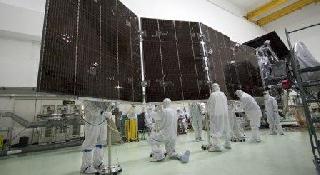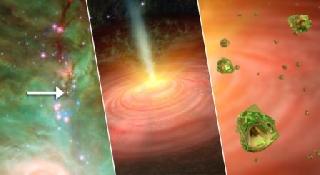
Technicians at Astrotech's payload processing facility in Titusville, Fla. stow solar array #2 against the body of NASA's Juno spacecraft. Photo by NASA/JPL-Caltech/KSC
PASADENA, CALIFORNIA (BNS): Three massive solar panels will provide power for NASA's Juno spacecraft during its mission to Jupiter.
The last of the Jupiter-bound spacecraft's panels completed pre-flight testing at the Astrotech payload processing and was folded against the side of the spacecraft into its launch configuration Thursday, a NASA JPL statement said.
The solar-powered Juno spacecraft will orbit Jupiter's poles 30 times to find out more about the gas giant's origins, structure, atmosphere and magnetosphere. The launch is scheduled for 5 August, 2011.
"Completing the testing and stow of solar panels is always a big pre-launch milestone, and with Juno, you could say really big because our panels are really big," said Jan Chodas, Juno's project manager.
"The next time these three massive solar arrays are extended to their full length, Juno will be climbing away from the Earth at about seven miles per second," he said.
This is the first time in history a spacecraft has used solar power so far out in space (Jupiter is five times farther from the sun than Earth).
Even with all the surface area pointed sunward, all three panels, which are 2.7 meters wide (9 feet), by 8.9 meters long (29 feet), will only generate about enough juice to power five standard light bulbs -- about 450 watts of electricity. If the arrays were optimized to operate at Earth, they would produce 12 to 14 kilowatts of power, the statement said.
 Previous Article
Previous Article Next Article
Next Article













The Indian Air Force, in its flight trials evaluation report submitted before the Defence Ministry l..
view articleAn insight into the Medium Multi-Role Combat Aircraft competition...
view articleSky enthusiasts can now spot the International Space Station (ISS) commanded by Indian-American astr..
view article